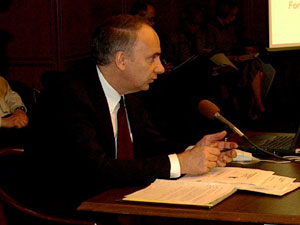Audio
Photos
Your Voice
| |||||||||||||||||||||||||||||||||||||||
Budget shortfall could reach $6 billion
January 9, 2003
St. Paul, Minn. — (AP) - Officially, Gov. Tim Pawlenty and lawmakers have a $4.56 billion projected deficit to cope with over the next 30 months.
But Senate Finance Committee Chairman Dick Cohen said after a briefing from state economist Tom Stinson on Thursday that he'll proceed as if the problem is at least $5 billion and as much as $6 billion.
Cohen is not convinced the state's economy is recovering as fast as hoped. He's worried about fallout from a possible war with Iraq. And he's intent on socking away $500 million or more as insurance against future downturns.
"The public perception is much less pessimistic than the reality is," said Cohen, DFL-St. Paul.
Although Stinson spent a lot of time talking about factors that could exacerbate Minnesota's fiscal woes, his presentation contained some good news.
A quarterly revenue update he plans to distribute Friday and a revised outlook from the state's economic consultant show things have perked up slightly. But Stinson cautioned that it's too early to tell if the new numbers are a lasting trend or just a blip.
Stinson won't revise the official deficit forecast until February, a document that will be the benchmark for budget deliberations the rest of the year.
On Monday, Gov. Tim Pawlenty plans to release a proposal to cover the $356 million deficit for this fiscal year, which must be erased before July. A senior adviser said the proposed solution will probably exceed the problem by $100 million or more in case revenues dip in the spring.
Pawlenty has vowed to handle the entire deficit without raising taxes and staying away from cuts to K-12 classrooms.
Stinson told the Senate committee that taking education spending off the table means every other part of the budget would have to be sliced by 25 percent to bring it into balance.
"It makes it that much more complicated," Cohen said.
Then there's the reserve debate. In the past, the state has tried to keep the equivalent of 5 percent of one year's budget in a rainy-day reserve, although some experts have suggested it would be wiser to have 5 percent for two years' spending on hand. Meeting the goals would mean setting aside anywhere from $500 million to $1.5 billion.
But in a year when legislators will be agonizing over cuts, some aren't sure it's practical to make deeper reductions so a reserve fund can be restocked.
"Clearly that's a political difficulty," said House Ways and Means Chairman Jim Knoblach, R-St. Cloud.
|
News Headlines
|
Related Subjects
|

